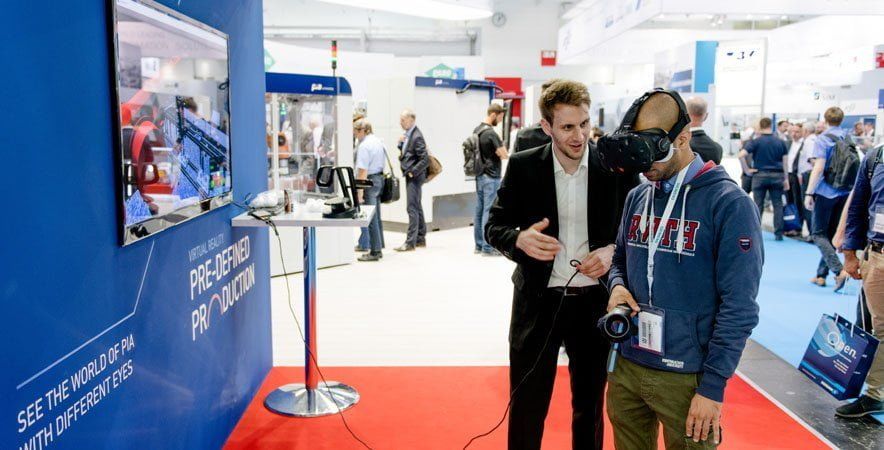Virtual Reality. Reality at PIA.

Virtual reality (VR) is becoming more and more popular within mechanical and plant engineering. Above all, great potential lies in the fact that complex automation connections can be mastered more easily because, for example, designers can experience their products in real time thanks to a digital image. PIA Automation has been using VR as an effective engineering tool for several years. Here, Christian Mehlsack (CM) and Thomas Kaufmann (TK) from the team "Standards & Development" (PIA Austria) go into more detail about virtual reality at PIA .
How long has PIA worked with VR?
CM: At our location in Austria we took up the topic in 2016. The background was an add-on of our 3D simulation software "Visual Components." This allowed us, without much effort, to create a VR video from the 3D layout of our mounting systems. Today, PIA Austria is the competence center for VR within the PIA Group. The topic is integrated within the "Standards & Development" team, which consists of approximatly 10 people.
How does the PIA network benefit from this?
TK: PIA is organized in strategic business units. Within the global PIA network synergy effects are used and the know-how of all locations is shared. This also applies to VR. Almost all of our locations have corresponding VR equipment with PIA Austria providing the technological knowledge to do so.
Which field of application is VR suitable?
CM: Ergonomics took priority during our deliberations on where we can use VR sensibly and in everyday business. In order to test and evaluate the quality of the ergonomics of a plant, the construction of cardboard boxes is a common process. This process (construction - measuring - creation of station models) can take several weeks and requires a great deal of resources. If the ergonomics are checked directly on the 3D model along with the use of VR glasses, you are faster, more effective, more efficient and simply more agile. Further, in addition to ergonomics, topics such as logistics, equipping stations and walkways can also be viewed digitally.

Christian Mehlsack (Standards & Development)
PIA is a partner to our customers when it comes to entering the digital age.
What is the specific value to your customers?
TK: Let's take the example of ergonomic acceptance again. Where no cardboard boxes are used, a look at the monitor (at a 2D model) must be sufficient to check the ergonomics. The assessment of how big the machine is or how high the tools are is not easy. VR, on the other hand, offers a different dimension of perception. In other words, with the help of VR, the customer sees and experiences exactly what they ultimately get from us. Another added value for the customer is the off-/online training of the operator. For example, training workers with VR is possible very early and without plant shutdown.
What more is possible in the future?
CM: The multi-user functionality is already in the works. Meaning, several people move through the model at the same time and can interact with each other. In other words, "Gamification within the field of engineering." It will not be long before sales people in an empty virtual space can assemble the perfect system for the customer. Haptic manages the strength and behavior of the feedback, hand-tracking - ie operation without a controller - or covering "real" distances in the simulation.
Sales has already been addressed. Does VR also serve as a marketing tool?
TK: VR is primarily used within our engineering but of course, the sales and marketing departments are also taking action. Notably, as soon as a 3D layout is available, a VR video can be created with a mouse click. The use of virtual reality is a "by-product" of our daily engineering process. Further, our VR simulation is not a "show element" but rather, 100% technology. The sales team benefits from this because as soon as 3D layouts are available the customer - even in the bidding phase - can enter virtual reality and move through their future system.
Thomas Kaufmann (Simulation Engineer)
With the help of VR, the customer has the opportunity to see exactly what they get from us.

What has been the customer's response to VR?
CM: It is rare that customers demand a VR simulation and in this area we are still raising awareness. As an example, one of the most renowned automobile manufacturers from Germany can be demonstrated here. Normally, the ergonomics test is carried out with cardboard boxes by this customer. We were able to convince them to do this review in a 2-day workshop using VR glasses and the customer was thrilled with the benefits. (1) Instead of weeks, the process only took days. (2) The 3D model achieved a very high level of detail (keyword: zoom). (3) The entire system was concentrated within a few square meters. (4) Any changes could be implemented quickly and easily. This example again shows that PIA is not just a plant engineer but rather, aides for our customers when it comes to entering the digital age.
Is augmented reality (AR) also an issue for PIA?
TK: It is difficult to use AR in the engineering process or in 3D layout planning because it requires the entire space of a plant. It gets exciting however, when a system is already in use. For instance, maintenance personnel can, with the help of a smartphone, within a certain area of the system "shine through" and retrieve information. There is great potential for future smart services that are already being developed at PIA.
How does PIA stay up-to-date?
CM: We work closely with DUALIS, which specializes in the development of software for simulation and process optimization. PIA is not just a user of DUALIS but a collaborator as well. Meanwhile, we are also a source of inspiration for the further development of the software and its VR features. An additional source of information is our ongoing exchange with experts from technical colleges and universities. When attending trade fairs and conventions, we monitor what is happening within the market and among our competitors and as the last Automatica demonstrated, PIA plays a leading role in the field of VR.